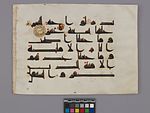Manuscript
About this object
History of use
A vellum leaf with text from the Qur'an, chapter 74, verses 22-31. The script adopted for this page is an example of the mature ‘Abbasid Kufic'. The artistic and aesthetic intentions of the scribe of this folio are evident in several aspects. There is a total absence of letter-pointing, an indication of the scribe’s intention to produce a script the defining character of which was artistic rather than functional. The scribe has also enhanced the calligraphic power of the script by the use of horizontal stretching of the letters. The absence of letter-pointing allows the austere, skeletal beauty of the Kufic script to be exhibited to its greatest effect, and it may indicate that the primary function of this manuscript was not to be read through by scholars and students as a working copy of the text, but to be admired as an object of sacred beauty; it was perhaps commissioned by a prince or wealthy dignitary, or may have been intended to be housed in a mosque.
Narrative
A section from this Qur’an manuscript is in the Bastan Museum, Tehran, Iran, and individual folios are in various private and institutional collections throughout the world. Could be from Iraq, Iran or Syria (or possibly North Africa?).
Cultural context
This manuscript leaf with text from the Qur’an is in Kufic script. In the early Islamic period, Arabic calligraphy was codified according to geometrical principles. Letter forms were defined with a precision that brings to mind a modern typeface, and the whole page was also laid out proportionally. In this piece, the scribe has enhanced the appearance of the script by stretching the letters horizontally. The absence of letter-pointing (usually consisting of thin black dashes) allows the austere, skeletal beauty of the Kufic script to be magnified. The manuscript was nevertheless intended for recitation, as shown by extensive vocalization (the notation of short vowels) through red dots. This particular page must have originally belonged to a lavish multi-volume Qur’an, probably endowed to a mosque or religious institution.
Physical description
Qur'an leaf, in Kufic script on vellum. The script is in dark brown ink on parchment, with seven lines per page. The vocalization is rendered in red dots, and single verse divisions are marked with triangular clusters of six gold discs. Fifth verse divisions are marked with a solidly coloured Kufic letter ha in gold (representing the number 5 in the abjad system), outlined in black. Tenth verse divisions are marked with an illuminated cusped roundel formed by interlacing gold and white bands decorated with elegant scrolls and dots containing the exact verse count – in this case thalathun (thirty) – on gold Kufic script on a reserved central space.
Date Made
850-900
Date Acquired
2 Jan 2013
How Acquired
Donated
Credit Line
A Gift from the Ismaili Muslim CommunityMore...
Measurements
Overall: 23.5 cm x 32.5 cm
Object Number
2988/1
